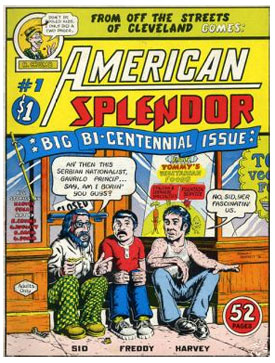Comic book writer and misfit Harvey Pekar spent his life bracing for the worst, and now, finally, he can relax.
Pekar was a non-fiction storyteller who recorded his daily existence for others to draw. In the medium of American comics, where the power fantasies of corporate superheroes in tights are the norm, Pekar's work stands out as the extraordinary testimony of an ordinary working-class man in an ordinary American city. Pekar’s main topic was the chronic ache of life, and reading his work brings relentless reminders that life takes death along for the ride.
 Newspapers have published lengthy obituaries on Pekar (see our list at the end of this post). Comic book fans and specialists have populated the Web with profiles of all kinds. Harvey Pekar was, for a time, a trending topic on Twitter. But Pekar has already told us about his life in excruciating detail, and so the best source on his life may well be Pekar himself.
Newspapers have published lengthy obituaries on Pekar (see our list at the end of this post). Comic book fans and specialists have populated the Web with profiles of all kinds. Harvey Pekar was, for a time, a trending topic on Twitter. But Pekar has already told us about his life in excruciating detail, and so the best source on his life may well be Pekar himself.
Encouraged by Robert Crumb in the early 1970s, Pekar started writing comics. Even when his work was illustrated by well-known graphic artists such as Crumb and Dean Haspiel, the creative spotlight was always on him as writer and protagonist. His work offered the ordinary adventures of a middle-aged file clerk suffering from a restless existential angst.
"Curmudgeonly" is perhaps the word most often used to describe him, but the tone and themes of his stories were as diverse as the team of artists who rendered his dialogue and plots. To read an issue of his “American Splendor” series is to perceive a single life as a polyphony where a character's psychological and physical identity is never the same.
So what was Harvey Pekar's contribution? How were his comics different?
A comic book author who could not draw, Pekar became one of the leading artistic figures of an often unappreciated medium. Like the graphic genius of underground masters Harvey Kurtzman and Crumb, Pekar's comics were an anomaly. Nothing in them reflected the "splendor" that had defined comics for decades. His narrative universe was in fact a form of "minor literature," focusing on the deliberately picayune instead of the grandiose.
Part Steinbeck and part Bukowski, Harvey Pekar unwittingly reimagined the Great American Novel as a comic book. If any greatness were to be found in this exercise, it would be in shedding light on the grim reality of everyday urban life. “American Splendor” did for comics what Allen Ginsberg's “Reality Sandwiches” did for poetry, but unlike Ginsberg, Pekar's writing was always part of a collaborative effort, where dramatic dialogue was waiting to be "performed" through the illustration styles of a gallery of artists.
Coming from the streets of Cleveland, “American Splendor” proved that "ordinary life is pretty complex stuff." The series was inserted into the black and white tradition of underground cartooning, but it shied away from the hallucinogenic scatology of the 1960s comix that Crumb and others pioneered. Unlike many of his peers, Pekar did not cater to fantasy. He made no attempt to imagine a better world. He simply wrote his life as he lived it, and in collaboration with the artists he created a very personal form of urban, hyper-local, working class, neurotic autobiographic storytelling. His narrative skills transcended the grids of printed comic book pages to reach the realms of film, music, and biography and webcomics.
Like other key figures of American comic book culture (Robert Crumb, Dan Clowes, Chris Ware) Harvey Pekar was a passionate collector of jazz records, and it is possible to read in his work the syncopated melancholy of an art form in danger of extinction. “Our Cancer Year,” the graphic novel he wrote with his wife Joyce Brabner, represents the height of his drive for the existential monologue, which he had inaugurated in an early collaboration with Crumb ("The Harvey Pekar Name Story," later translated into the 2003 film “American Splendor,” in which he played himself, as did star Paul Giamatti).
If ever there were a comic book tragic hero, it is Pekar. More Hamlet than Macbeth, he was constantly concerned with self-reflection and the imminence of death: the hospital archive where he worked most of his life until retirement was a constant reminder of life's futility, and therefore of the importance of stories not usually told. Pekar's storytelling was, most literally, a survival mechanism, a life-affirming exercise.
His aesthetic and political perspective acquired the critical appreciation of an educated elite; nevertheless Pekar wanted to write "clearly" in order to be understood by everyone. In 2003, he appeared in a movie about his life and work, and his belief that "you can do anything with comics" guided his life project.
In his final years, Pekar told the story of his troubled teenage years for the first time in “The Quitter,” which received widespread critical acclaim. For Smith magazine, Pekar worked with a team on "The Pekar Project," creating an ongoing webcomic series to explore in different formats and styles his concerns about life and death in corporate America. His last work is journalistic in nature, offering glimpses of what the future of online, non-fiction graphic reporting might become.
Pekar achieved an intensely personal, visual body of work that was nonetheless collaborative. Seamlessly combining the short story with long-form narrative, he employed his obsessed depression to illuminate the beauty of the mundane.
In Harvey Pekar's comics, life and art merge, but between the romantic ideal of success and the objective hardship of daily life, there is still a chasm. Pekar might have been successful enough to become a regular guest on David Letterman, but his pen (and tongue) remained too sharp to settle in the soft focus of mass media. His work was tense with contradictions: optimistic in its negativity and funny in its seriousness. Moreover, in a medium built on fantasy and lies it told the uncomfortable truth.
[For more on Harvey Pekar's life, see these links to obituaries and remembrances worth checking out, from Cleveland’s The Plain Dealer, the Los Angeles Times, The New York Times (with others here and here), New York Daily News, The Washington Post, The Washington Post’s comics blog, Mediaite, Comics Reporter, Comics Beat, The Comics Journal and The Guardian.]
Ernesto Priego is researching comics and narrative as a Ph.D. candidate in information studies in the U.K. at University College London. He has written previously for Nieman Storyboard on manga memoir and on comics as narrative journalism.
Pekar was a non-fiction storyteller who recorded his daily existence for others to draw. In the medium of American comics, where the power fantasies of corporate superheroes in tights are the norm, Pekar's work stands out as the extraordinary testimony of an ordinary working-class man in an ordinary American city. Pekar’s main topic was the chronic ache of life, and reading his work brings relentless reminders that life takes death along for the ride.
 Newspapers have published lengthy obituaries on Pekar (see our list at the end of this post). Comic book fans and specialists have populated the Web with profiles of all kinds. Harvey Pekar was, for a time, a trending topic on Twitter. But Pekar has already told us about his life in excruciating detail, and so the best source on his life may well be Pekar himself.
Newspapers have published lengthy obituaries on Pekar (see our list at the end of this post). Comic book fans and specialists have populated the Web with profiles of all kinds. Harvey Pekar was, for a time, a trending topic on Twitter. But Pekar has already told us about his life in excruciating detail, and so the best source on his life may well be Pekar himself.Encouraged by Robert Crumb in the early 1970s, Pekar started writing comics. Even when his work was illustrated by well-known graphic artists such as Crumb and Dean Haspiel, the creative spotlight was always on him as writer and protagonist. His work offered the ordinary adventures of a middle-aged file clerk suffering from a restless existential angst.
"Curmudgeonly" is perhaps the word most often used to describe him, but the tone and themes of his stories were as diverse as the team of artists who rendered his dialogue and plots. To read an issue of his “American Splendor” series is to perceive a single life as a polyphony where a character's psychological and physical identity is never the same.
So what was Harvey Pekar's contribution? How were his comics different?
A comic book author who could not draw, Pekar became one of the leading artistic figures of an often unappreciated medium. Like the graphic genius of underground masters Harvey Kurtzman and Crumb, Pekar's comics were an anomaly. Nothing in them reflected the "splendor" that had defined comics for decades. His narrative universe was in fact a form of "minor literature," focusing on the deliberately picayune instead of the grandiose.
Part Steinbeck and part Bukowski, Harvey Pekar unwittingly reimagined the Great American Novel as a comic book. If any greatness were to be found in this exercise, it would be in shedding light on the grim reality of everyday urban life. “American Splendor” did for comics what Allen Ginsberg's “Reality Sandwiches” did for poetry, but unlike Ginsberg, Pekar's writing was always part of a collaborative effort, where dramatic dialogue was waiting to be "performed" through the illustration styles of a gallery of artists.
Coming from the streets of Cleveland, “American Splendor” proved that "ordinary life is pretty complex stuff." The series was inserted into the black and white tradition of underground cartooning, but it shied away from the hallucinogenic scatology of the 1960s comix that Crumb and others pioneered. Unlike many of his peers, Pekar did not cater to fantasy. He made no attempt to imagine a better world. He simply wrote his life as he lived it, and in collaboration with the artists he created a very personal form of urban, hyper-local, working class, neurotic autobiographic storytelling. His narrative skills transcended the grids of printed comic book pages to reach the realms of film, music, and biography and webcomics.
Like other key figures of American comic book culture (Robert Crumb, Dan Clowes, Chris Ware) Harvey Pekar was a passionate collector of jazz records, and it is possible to read in his work the syncopated melancholy of an art form in danger of extinction. “Our Cancer Year,” the graphic novel he wrote with his wife Joyce Brabner, represents the height of his drive for the existential monologue, which he had inaugurated in an early collaboration with Crumb ("The Harvey Pekar Name Story," later translated into the 2003 film “American Splendor,” in which he played himself, as did star Paul Giamatti).
If ever there were a comic book tragic hero, it is Pekar. More Hamlet than Macbeth, he was constantly concerned with self-reflection and the imminence of death: the hospital archive where he worked most of his life until retirement was a constant reminder of life's futility, and therefore of the importance of stories not usually told. Pekar's storytelling was, most literally, a survival mechanism, a life-affirming exercise.
His aesthetic and political perspective acquired the critical appreciation of an educated elite; nevertheless Pekar wanted to write "clearly" in order to be understood by everyone. In 2003, he appeared in a movie about his life and work, and his belief that "you can do anything with comics" guided his life project.
In his final years, Pekar told the story of his troubled teenage years for the first time in “The Quitter,” which received widespread critical acclaim. For Smith magazine, Pekar worked with a team on "The Pekar Project," creating an ongoing webcomic series to explore in different formats and styles his concerns about life and death in corporate America. His last work is journalistic in nature, offering glimpses of what the future of online, non-fiction graphic reporting might become.
Pekar achieved an intensely personal, visual body of work that was nonetheless collaborative. Seamlessly combining the short story with long-form narrative, he employed his obsessed depression to illuminate the beauty of the mundane.
In Harvey Pekar's comics, life and art merge, but between the romantic ideal of success and the objective hardship of daily life, there is still a chasm. Pekar might have been successful enough to become a regular guest on David Letterman, but his pen (and tongue) remained too sharp to settle in the soft focus of mass media. His work was tense with contradictions: optimistic in its negativity and funny in its seriousness. Moreover, in a medium built on fantasy and lies it told the uncomfortable truth.
[For more on Harvey Pekar's life, see these links to obituaries and remembrances worth checking out, from Cleveland’s The Plain Dealer, the Los Angeles Times, The New York Times (with others here and here), New York Daily News, The Washington Post, The Washington Post’s comics blog, Mediaite, Comics Reporter, Comics Beat, The Comics Journal and The Guardian.]
Ernesto Priego is researching comics and narrative as a Ph.D. candidate in information studies in the U.K. at University College London. He has written previously for Nieman Storyboard on manga memoir and on comics as narrative journalism.


